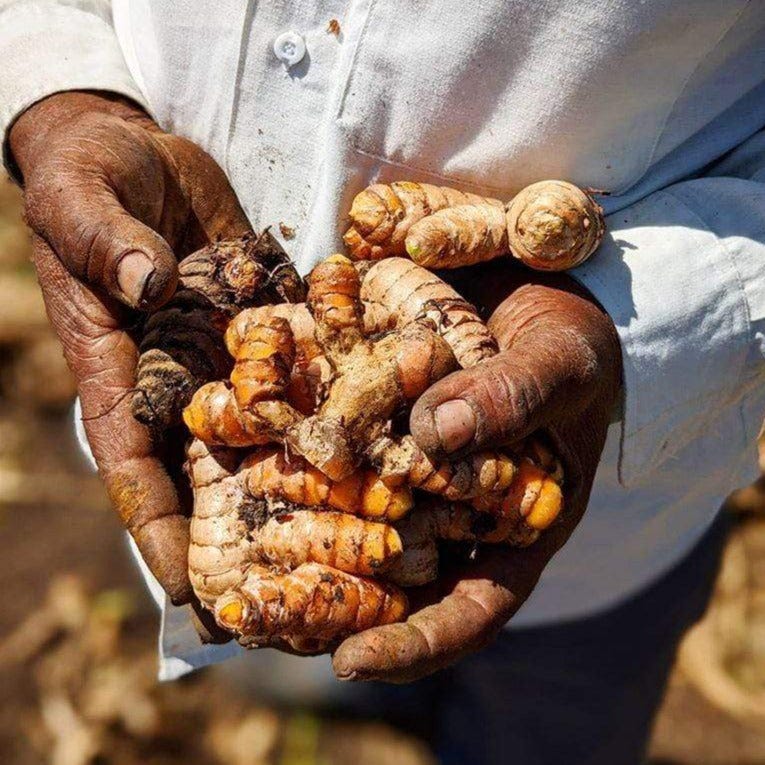I hosted a cooking class last Saturday. I said this nonchalantly, but believe me I was and am screaming inside. IT. WAS. SO. FUN! We cooked traditional Indonesian food: ayam ungkep, telur balado, sayur bobor (think of it as a mash up of sayur lodeh and sayur bening). If you’re lucky, you may have ART/mbak to cook it for you. If not, then it’s everywhere in warteg. It’s easy to find but we take it for granted, so much so that we never get to learn what goes in it and how to cook it.
To cook that, first we need to know our spices. And girl, we learned. Tell me, do you know what this spice is below?
Ginger? Turmeric? Something else entirely? You’ll find the answer when you reach the bottom. Nuh-uh don’t cheat, bear with me. Patience is a virtue.
Call this an unofficial guide, but I’d like to think that in an Indonesian kitchen, we get acquainted with whole spices and seasonings in three levels:
Level 1 are the most easily recognized, widely used essentials. You can get away cooking many dishes with just these. Salt and pepper, chili, allium family - bawang merah (shallot), bawang putih (garlic), bawang bombay (onion)
Level 2 are familiar and important spices, but not everyone have them in their pantry. Daun salam (bay leaf), daun jeruk (kaffir lime leaves), sereh (lemongrass), kemiri (candle nut), kayu manis (cinnamon), root family - jahe (ginger), kunyit (turmeric), lengkuas (galangal), kencur (I don’t know the english name for this, aromatic ginger?)
Level 3 spices may sound serious and intimidating but I promise you, they’re not. It’s those “exotic” spices you see on recipes and ask “yeah, but what am I gonna do with the rest afterwards?!” and skip cooking it altogether. Pala (nutmeg), cengkeh (clove), cumin (jinten), ketumbar (coriander), kapulaga (cardamom), bunga lawang/pekak (star anise), asam jawa (tamarind), temulawak, temu ireng, secang (again, english name unknown)
Let’s save level 3 for another day. Today, we’ll take on level 2 and learn how to tell the root family - jahe, kunyit, lengkuas, and kencur - apart.
Ready to get spice-y?
Jahe (ginger)
Use your strongest sense: smell. Out of all four, ginger is most likely the smell you are most familiar with.. so use it. It smells warm and spicy. Visually, it’s chunkier than the rest with light, fibrous skin and yellow-ish flesh.
Lengkuas (galangal)
I think ginger and galangal are the hardest ones to tell apart. Compared to ginger, galangal doesn’t have that distinctive smell. Galangal’s skin is smoother but its flesh is harder, therefore it can’t be grated. It’s pale, with pink-ish tinge.
Kunyit (turmeric)
If you’re Indonesian just remember this, kunyit : kuning. It’s easiest to tell visually, with darker, slightly translucent skin that shows the yellow-orange flesh inside. You know you’ll never forget about this spice when you can’t wash it off your hands and clothes, it’s a very powerful natural coloring, so beware.
Kencur (Google said it’s called “aromatic ginger”? Dunno, indeed I couldn’t find it when I was in Europe)
Smaller and chunkier. The skin looks more brown than the rest. If you know how sayur bening or beras kencur jamu smells like, then this would smell exactly that.
There you go, phew! Hopefully I didn’t write all of that for nothing, and that you will now be able to tell those spices apart. With those spices, you can make empon-empon - an Indonesian traditional drink which popularity surged during the pandemic… but I think it deserves to stay in our drinks repertoire.
Empon-empon
Three 3-cm ginger, peeled, smashed, and sliced
Two 3-cm turmeric, peeled, smashed, and sliced
2 lemongrass, first layer peeled then smashed
2 3-cm temulawak, peeled, smashed, and sliced
1 tsp whole black pepper, smashed
600ml water
Lime and honey to taste
To make:
Boil water, add all spices, and simmer for 10-15 minutes. Strain the spices and let cool. Add lime and honey to taste. Enjoy!
Note: the traditional empon-empon doesn’t usually use black pepper. I added it because black pepper contains piperine, a bioactive compound that allows better absorption of curcumine, the antioxidant compound found in turmeric.







